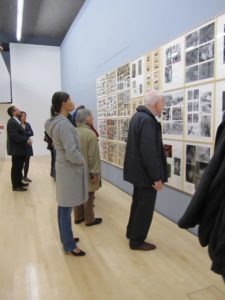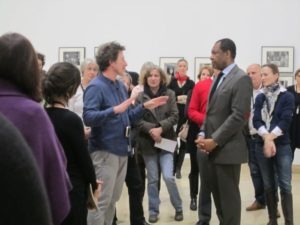
by Jean Marie Carey | 10 Nov 2013 | Art History, Franz Marc, German Expressionism / Modernism

Atlas Mikromega @ the Lenbachhaus
A few years ago I went through a phase of being consumed with interest in Gerhard Richter’s cycle of 15 paintings, Baader-Meinhof (18. Oktober 1977). Writing this now my obsession seems doubly strange because I did not then have the geographic or cultural context for these works I have in 2013. One spring break I had seen the paintings – based upon photographs of Ulrike Meinhof, Holger Meins, Gudrun Ensslin, Andreas Baader; the funeral of Jan-Carl Raspe, and Baader’s books and record player – at the Museum of Modern Art and had a very strong reaction to them. I think I explored this subject so intently because my response was the opposite from my feelings for Franz Marc’s animals. The blurred details of the black and white photographs of portraits, news stills, and police snapshots made the subjects abjectly lifeless. The effect was like the dream of freezing; cold, sad, and bitterly empty. The paintings made me drained and ill. Yet I was fascinated by the tension – and desire – that was generated by being repelled by images whose subjects I was very drawn to.
(more…)

by Jean Marie Carey | 9 Jun 2013 | Art History, German Expressionism / Modernism

There were opportunities during Isabelle Graw’s presentation this past week at the Lenbachhaus to make some some site-specific comments about the collections at hand, and Graw did make tangential connections to work by Joseph Beuys and Wolfgang Tillmans, thought not those which belongs to the museum’s Kunst Nach 1945 collection.
Intensely and yet breezily theoretical (I have heard Graw speak several times, on one of those occasions dismissing the Adorno-Horkheimer ‘culture industry’ works most art historians spend their lives trying to understand as insufficiently complex for her needs in explaining the reification of art) Graw is an engaging speaker, readily admitting that many of her contentions create oppositional paradoxes which thus cannot be argued against. Graw herself occupies dual roles, as professor for Art Theory and Art History at Staatliche Hochschule für Bildende Künste in Frankfurt am Main and as an art critic and co-founder of Texte zur Kunst, the respectable but for-profit Berlin art journal. Graw also has a heavy amount of street cred coming from a lengthy association with Martin Kippenberger during Kippenberger’s time in Cologne.
 Her talk at the Lenbachhaus, Malerei als indexikalisches Medium in der neuen Ökonomie recasts the idea that paintings are “alive” somehow in the sense that they emanate an autonomous value in terms of the role of Painting with a “P” as both commodity and part of the larger “organism” of the process and documentation of the making of art.
Her talk at the Lenbachhaus, Malerei als indexikalisches Medium in der neuen Ökonomie recasts the idea that paintings are “alive” somehow in the sense that they emanate an autonomous value in terms of the role of Painting with a “P” as both commodity and part of the larger “organism” of the process and documentation of the making of art.
Indexical is a word mostly associated in art history with photography, and photography is important to Graw’s current interest, which expands upon many of the ideas she raised in her recent book High Price: Art Between the Market and Celebrity Culture in the sense that “documentary indexicality” is all but a de-facto given the ubiquity of record-making technology. Additionally, in the trinity of “icon/index/symbol,” “index” marks a definite place and time by compelling a reaction in the beholder. But I think it is the more abstruse “referential indexicality” that most interests Graw in this sense, as she used Diedrich Diedrichsen’s term “Selbstdarsteller” to describe Kippenberger’s performances of himself as himself (as opposed to performing “the other” or just “being” himself).
(more…)

by Jean Marie Carey | 14 Apr 2013 | Art History, Re-Enactments© and MashUps

Gideon Mendel and Okwui Enwezor at Haus der Kunst.
I approached the tour of the exhibition The Rise and Fall of Apartheid (10 April 2013 at Haus der Kunst) featuring curator Okwui Enwezor and photographer Gideon Mendel with equal parts hopefulness and skepticism. The conversation and the galleries of photographs and videos were very interesting and relatively straightforwardly informational, and impressively accessible.
The event was arranged in quite a different manner than other “conversations” of this type I’ve attended before. Enwezor and Mendel actually occupied the same space as the 30 or so low-key attendees who surrounded the speakers attentively but not crushingly, giving listening and looking but not acting at all starstruck from being inches away from one of the most influential curators in the world.
The centerpiece of the talk was perhaps Mendel’s music and photo installation Yeoville, created especially for this exhibition and featuring the music of Dynamics, a South African band Mendel says he strongly associates with the mid-1980s when many of these photos were taken. Cropped to isolate details alternating with full-frame shots, these projections show Johannesburg residents during these years interacting in leisure and daily life in quotidian activities that nonetheless show, through the engagement of the mix of races and generations, the gradual, natural, erosion of the Apartheid system.
Mendel has much other work in the exhibition including a stunning color series of some Afrikaans “heritage” re-enactors. South African Jürgen Schadeberg’s work spanning 50 years is also wide-ranging. Most stunning, to me, were some of the covers and images from the 1950s magazine Drum, one of which stunningly restored the recently deceased Miriam Makeba to vibrant zenith. (more…)

by Jean Marie Carey | 9 Aug 2011 | Animals, Animals in Art, Art History, Dogs!, Franz Marc, German Expressionism / Modernism, Stuff Found in Library Books

Franz Marc holding a cell phone, 1915.
Here is a mysterious photograph from Franz Marc – Paul Klee: ein Dialog in Bildern, a volume beautifully illustrated with the artists’ postcards to each other and some interesting photographs. Klee seems more vulnerable and less arch than you might expect in these letters and drawings. Marc, maybe predictably, sort of absorbs and reflects Klee; yet the images and texts on the cards seem both entwined and quotidian. One of the photos is this fascinating unsourced image, captioned “Franz Marc im Unterstand, 1915/1916.” It’s hard to tell what kind of shelter this is…it appears shell-shocked and comfortable at the same time. There are some binoculars and map cases hanging, and an eerie prophetic broken mirror. FM is smoking, of course, but the captivating question is what is he holding?
It looks like a cell phone, the kind you would expect FM to have, not a Blackberry or an iPhone, just a functional Nokia with Alpenlaendische Volksmusik ringtones. Photography professors, librarians, and two photo archivists who specialize in early 20th Century images looked at this photo and everyone was perplexed about the photo shows. That’s just how FM rolls.
What do you think this object is?
This book (which is confusingly cataloged with lots of commas instead of the conjunctions and articles that appear actually in print) forms the combined catalog from three retrospectives from 2010 at
the Franz Marc Museum in Kochel am See; the Stiftung Moritzburg (“Kunstmuseum des Landes Sachsen-Anhalt” in Halle, the craziest city in Flemish Brabant and the planet); and Zentrum Paul Klee in Bern.

by Jean Marie Carey | 27 Jul 2008 | Animals, Art History

[Green turtle, albino. By David Monniaux]
“To photograph is to appropriate the thing photographed.”
On Photography, Susan Sontag’s exhaustive critique of photography, which excoriated photographers even as it elevated the art form, opens (in the 1977 book form of the collected essays) with the chapter “In Plato’s Cave.” Arranged and edited in this manner this chapter is meant to serve as the introduction to Sontag’s collection of ideas on the sociological implications of the medium of photography.
So much has been written by and about Sontag with respect to the construction and importance of these essays, and so much biographical detail about Sontag has come to light since her death a few years ago, that is it difficult to consider “In Plato’s Cave” unto itself, separate from that information, let alone separate from the other essays in the collection.
Basically, Sontag takes humankind to task, as did Plato, for sitting around accepting whatever images that happen to dance past as a perfect mirror (or projection) of reality and judges photographers equally harshly for approaching their subjects with acquisitiveness and predation. Sontag investigates the simile of the cave but more deeply the metaphor of the mirror.
I was interested to learn that Sontag had also written extensively about Persona, the 1966 Ingmar Bergman film, probably around the same time she began the series of essays that are collected in On Photography. Persona can also be construed as being about mirroring, and also about a kind of (seemingly) passive transmission and reception of knowledge, as well as a complicated examination about the relationship between the beholder and the beheld. Persona is open to interpretation as a horror movie rather than a psychological study, one in which a very modern sort of vampire sucks the being from a similar but not identical human. (more…)







